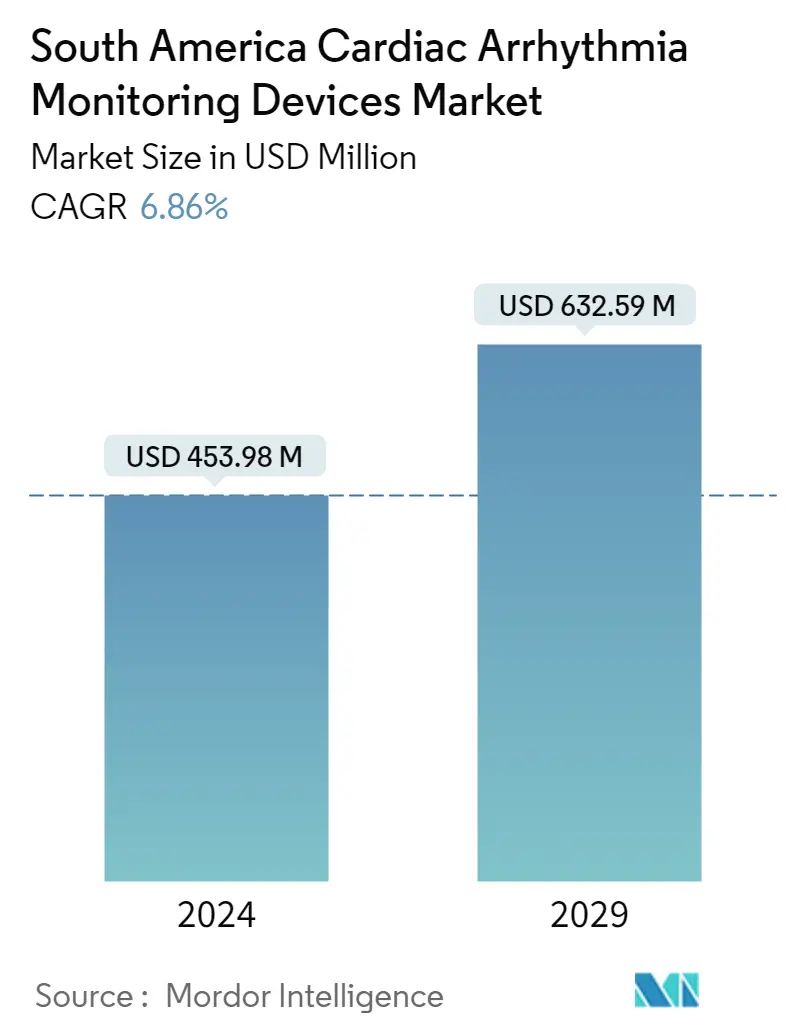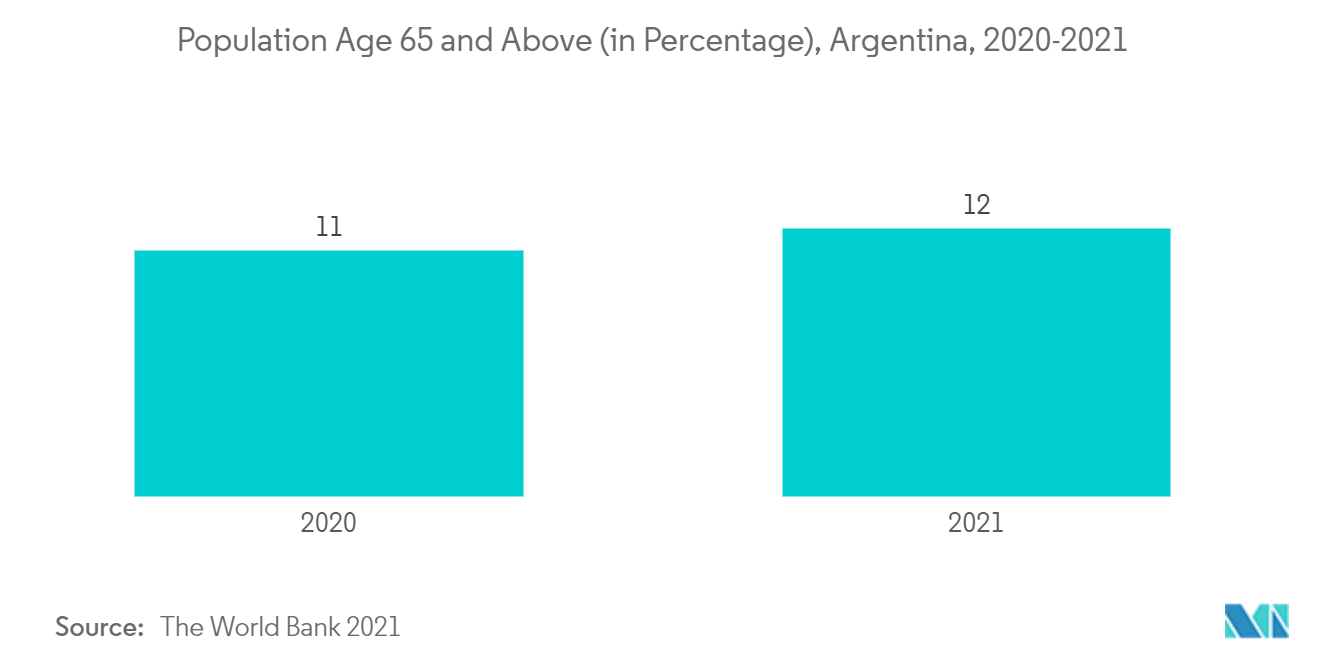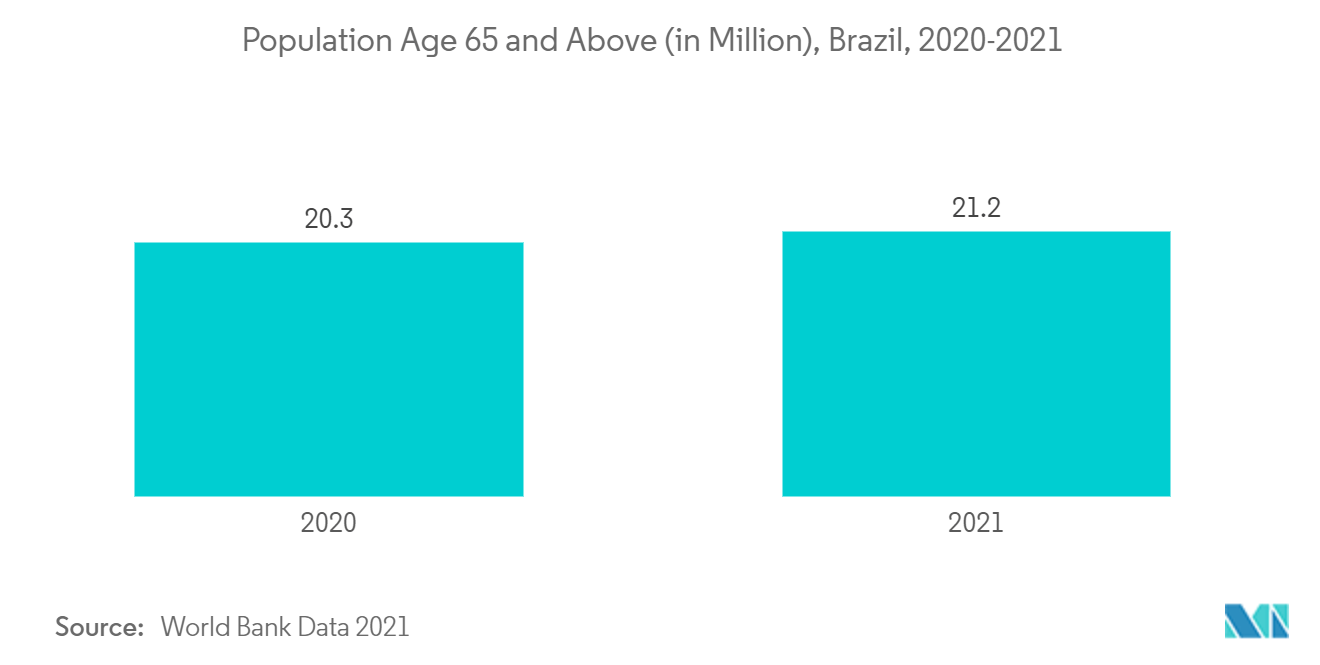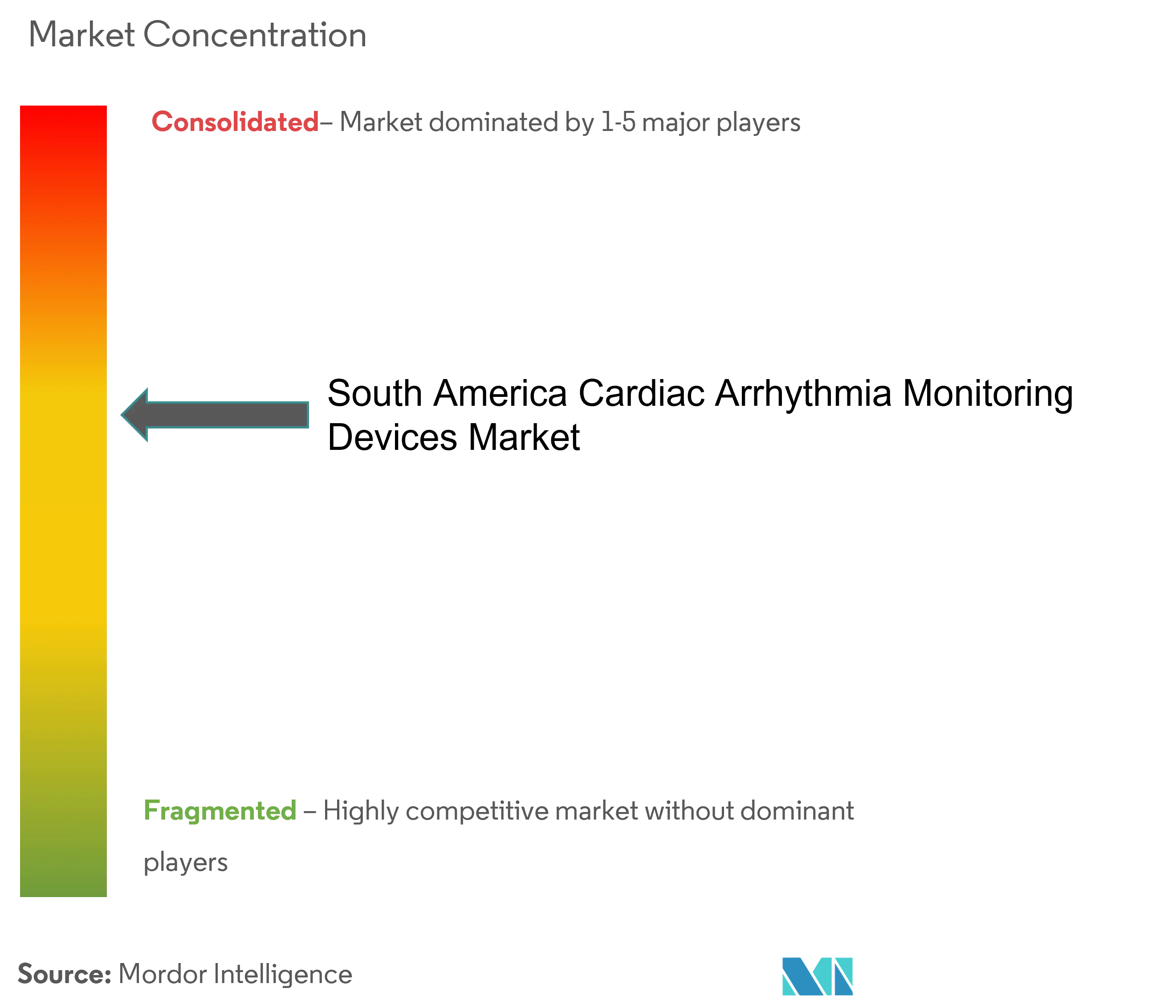South America Cardiac Arrhythmia Monitoring Devices Market Size

| Study Period | 2021 - 2029 |
| Base Year For Estimation | 2023 |
| Market Size (2024) | USD 453.98 Million |
| Market Size (2029) | USD 632.59 Million |
| CAGR (2024 - 2029) | 6.86 % |
| Market Concentration | Medium |
Major Players
*Disclaimer: Major Players sorted in no particular order |
South America Cardiac Arrhythmia Monitoring Devices Market Analysis
The South America Cardiac Arrhythmia Monitoring Devices Market size is estimated at USD 453.98 million in 2024, and is expected to reach USD 632.59 million by 2029, growing at a CAGR of 6.86% during the forecast period (2024-2029).
COVID-19 created difficulties for physicians whose cardiac patients are at risk and hesitant to come in for an appointment. The emergence of the COVID-19 pandemic initially had a negative impact on the cardiac arrhythmia monitoring business. Many medical treatments were suspended and used only in critical and emergency situations to reduce the danger of COVID-19 infection. The global lockdown had impacted the supply chain of pharmaceuticals, medical equipment, and biotechnology products. Furthermore, as a result of the developing cardiac problems linked with COVID-19, the market for arrhythmia monitoring devices was expected to rise in the future. According to the study published by World Health Organization in July 2021, COVID-19 individuals with cardiac disease were at a higher risk of complications or death, with a higher incidence of myocardial damage, shock, and arrhythmias. In COVID-19 individuals, the incidence of cardiovascular problems was 10% with supraventricular arrhythmia and 7.3% with ventricular arrhythmia. Atrial fibrillation was the most common arrhythmic complication in COVID-19 patients. Thus, the studied market was significantly impacted by the COVID-19 pandemic. However, the business has recovered well since the limitations were relaxed. The market recovery over the previous two years has been led by the increasing prevalence of heart illnesses new product introductions.
The market is driven by the increase use of telecardiology and the ease of use and portability of cardiac arrhythmia monitoring devices. According to the study published in SciELO Brazil in August 2021, cardiovascular diseases (CVDs) account for almost one-third of all fatalities in Brazil, as populations live longer, chronic diseases such as CVDs become more common. Telecardiology bridged the gap between the patient and the specialist professional, resulting in high patient and health professional satisfaction. As a result, the Pontifical Catholic University of Rio Grande do Sul (PUCRS) and the Institute of Cardiology of Rio Grande do Sul (ICFUC-RS) in Porto Alegre have launched a telecardiology program and a specific second opinion service to detect vulnerable CVD and improve local health care in 2020. Such initiatives are expected to boost market growth.
Cardiovascular diseases are the major cause of death in South America, which has increased the need for the development of cardiac monitoring devices in the region. According to a research study published in Diabetes nad Metabolic Syndrome in January 2022, In the Brazil sample, the prevalence of CVD and atherosclerotic CVD was 43.9% and 37.6%, respectively. Other factors, such as ease of use and portability of cardiac arrhythmia monitoring devices and the development of smart cardiac monitors are driving the South American cardiac arrhythmia monitoring devices market. However, the high cost of cardiac monitoring devices may restrain the market growth over the forecast period.
South America Cardiac Arrhythmia Monitoring Devices Market Trends
This section covers the major market trends shaping the South America Cardiac Arrhythmia Monitoring Devices Market according to our research experts:
Holter Monitoring Devices is Expected to Hold the Significant Market Share During the Forecasted period
Holter monitoring devices dominate the market as these devices can be used for longer durations for diagnosing sporadic symptoms in suffering patients. They also offer faster and more convenient monitoring to increase patient compliance and are likely to enhance the treatment outcome. Furthermore, there are several advancements taking place in the cardiac arrhythmia monitoring devices market and these advances are rapidly increasing, which in turn, is driving the cardiac arrhythmia monitoring devices market.
According to a study published in European Heart Journal in August 2022, the incidence of CVD (per 1000 person-years) varied between countries, with Brazil having the highest incidence (3.86) and Argentina having the lowest (3.07). Mortality rates (per 1000 person-years) varied more between countries, with Argentina having the highest (5.98) and Chile having the lowest (4.07). Men had a higher CVD incidence (4.48 vs. 2.60 per 1000 person-years) and mortality rate (6.33 vs. 3.96 per 1000 person-years) than women. This will increase the demand for Holter monitoring devices, which will positively impact market growth.
The geriatric population is more prone to cardiovascular diseases and thus the demand for cardiac arrhythmia monitoring devices is expected to be high in this population thereby boosting the growth of the market.
Thus, all aforementioned factors such as the benefits of holter monitoring devices and the growing prevalence of cardiovascular diseases are expected to boost segment growth over the forecast period.

Brazil is Expected to Hold a Significant Share in the Market and Expected to do Same in the Forecast Period
The government of Brazil is progressive, and the country's population is expanding.The market for cardiac arrhythmia monitoring is benefiting from a nationwide trend toward the private health sector in the country. Growth in the Brazilian market is expected to be particularly robust during the projection horizon. The rising prevalence of cardiovascular diseases, an aging population, and rising consumer awareness are all factors propelling the regional market forward.
As per an article published in BMC Cardiovascular Disorders in June 2020, reported that Heart failure (21.3%), other ischemic heart diseases (13.3%), and stroke (11.4%) were responsible for almost half of the hospital admissions associated with CVD. Thus, the high incidence of cardiovascular diseases in the country will drive market growth.
Moreover, the presence of universal health coverage in the country is likely to support the growth of the market. According to the Americas Society/Council of The Americas in August 2021, Brazil is the world's only country with a population of more than 100 million that has a universal healthcare system. The SUS's Family Health Strategy is the world's largest community-based primary care program, serving over 60% of the Brazilian population. Every year, the SUS covers more than 2 million births, 10 million hospital admissions, and approximately 1 billion outpatient operations - all of which are provided free of charge to all Brazilians.
Because the older population is more susceptible to cardiovascular disorders, demand for cardiac arrhythmia monitoring devices is predicted to be strong in this group, increasing market growth. Thus, all the above-mentioned factors such as growing budern of CVD in Brazil and healthcare coverage by SUS are expected to propel the growth of the market in the country.

South America Cardiac Arrhythmia Monitoring Devices Industry Overview
The South America cardiac arrhythmia monitoring market is moderately competitive, with the presence of several global and international market players. The global key players are manufacturing the majority of cardiac arrhythmia monitoring devices. Some of the market players are Abbott Laboratories, GE Healthcare, Medtronic PLC, Boston Scientific Corporation, Koninklijke Philips N.V. and among other.
South America Cardiac Arrhythmia Monitoring Devices Market Leaders
-
Abbott Laboratories
-
GE Healthcare
-
Medtronic PLC
-
Boston Scientific Corporation
-
Koninklijke Philips N.V.
*Disclaimer: Major Players sorted in no particular order

South America Cardiac Arrhythmia Monitoring Devices Market News
- February 2021 : Royal Philips announced that it had completed the acquisition of BioTelemetry Inc., the remote cardiac diagnostics and monitoring device manufacturer in the industry.
- January 2021 : Boston Scientific announced that it entered a definitive agreement to acquire Preventice Solutions Inc., a privately-held company that offers a full portfolio of mobile cardiac health solutions and services, ranging from ambulatory cardiac monitors - including short and long-term Holter monitors - to cardiac event monitors and mobile cardiac telemetry.
South America Cardiac Arrhythmia Monitoring Devices Market Report - Table of Contents
1. INTRODUCTION
- 1.1 Study Assumptions and Market Definition
- 1.2 Scope of the Study
2. RESEARCH METHODOLOGY
3. EXECUTIVE SUMMARY
4. MARKET DYNAMICS
- 4.1 Market Overview
-
4.2 Market Drivers
- 4.2.1 Increasing Use of Telecardiology
- 4.2.2 Ease of Use and Portability of Cardiac Arrhythmia Monitoring Devices
-
4.3 Market Restraints
- 4.3.1 High Cost of Cardiac Monitoring Devices
-
4.4 Porter's Five Force Analysis
- 4.4.1 Threat of New Entrants
- 4.4.2 Bargaining Power of Buyers/Consumers
- 4.4.3 Bargaining Power of Suppliers
- 4.4.4 Threat of Substitute Products
- 4.4.5 Intensity of Competitive Rivalry
5. MARKET SEGMENTATION (Market Size by Value - USD million)
-
5.1 By Devices
- 5.1.1 Event Monitoring Devices
- 5.1.2 Continuous Rhythm Monitoring Devices
- 5.1.3 Holter Monitoring Devices
- 5.1.4 Other Devices
-
5.2 By Service Providers
- 5.2.1 Mobile Cardiac Telemetry Monitoring Service Providers
- 5.2.2 Independent Diagnostic Testing Facilities/Clinics
-
5.3 Geography
- 5.3.1 South America
- 5.3.1.1 Brazil
- 5.3.1.2 Argentina
- 5.3.1.3 Rest of South America
6. COMPETITIVE LANDSCAPE
-
6.1 Company Profiles
- 6.1.1 AliveCor, Inc.
- 6.1.2 Abbott Laboratories
- 6.1.3 Biotronik
- 6.1.4 GE Healthcare
- 6.1.5 Medtronic PLC
- 6.1.6 Koninklijke Philips NV
- 6.1.7 BioTelemetry, Inc.
- 6.1.8 Boston Scientific Corporation
- *List Not Exhaustive
7. MARKET OPPORTUNITIES AND FUTURE TRENDS
** Subject To AvailablitySouth America Cardiac Arrhythmia Monitoring Devices Industry Segmentation
As per the scope of the report, cardiac arrhythmia monitoring devices are used for monitoring patients at risk or with heart arrhythmia. These devices detect and alarm the heartbeats that are irregular being either too slow or too fast. The South America Cardiac Arrhythmia Monitoring Devices Market is segmented by Devices (Event Monitoring Devices, Continuous Rhythm Monitoring Devices, Holter Monitoring Devices, Other Devices), Service Providers (Mobile Cardiac Telemetry Monitoring Service Providers, Independent Diagnostic Testing Facilities/Clinics), and Geography (Brazil, Argentina, and Rest of South America). The report offers the value (in USD million) for the above segments.
| By Devices | Event Monitoring Devices | |
| Continuous Rhythm Monitoring Devices | ||
| Holter Monitoring Devices | ||
| Other Devices | ||
| By Service Providers | Mobile Cardiac Telemetry Monitoring Service Providers | |
| Independent Diagnostic Testing Facilities/Clinics | ||
| Geography | South America | Brazil |
| Argentina | ||
| Rest of South America |
South America Cardiac Arrhythmia Monitoring Devices Market Research FAQs
How big is the South America Cardiac Arrhythmia Monitoring Devices Market?
The South America Cardiac Arrhythmia Monitoring Devices Market size is expected to reach USD 453.98 million in 2024 and grow at a CAGR of 6.86% to reach USD 632.59 million by 2029.
What is the current South America Cardiac Arrhythmia Monitoring Devices Market size?
In 2024, the South America Cardiac Arrhythmia Monitoring Devices Market size is expected to reach USD 453.98 million.
Who are the key players in South America Cardiac Arrhythmia Monitoring Devices Market?
Abbott Laboratories, GE Healthcare, Medtronic PLC, Boston Scientific Corporation and Koninklijke Philips N.V. are the major companies operating in the South America Cardiac Arrhythmia Monitoring Devices Market.
What years does this South America Cardiac Arrhythmia Monitoring Devices Market cover, and what was the market size in 2023?
In 2023, the South America Cardiac Arrhythmia Monitoring Devices Market size was estimated at USD 424.84 million. The report covers the South America Cardiac Arrhythmia Monitoring Devices Market historical market size for years: 2021, 2022 and 2023. The report also forecasts the South America Cardiac Arrhythmia Monitoring Devices Market size for years: 2024, 2025, 2026, 2027, 2028 and 2029.
South America Cardiac Arrhythmia Monitoring Devices Industry Report
Statistics for the 2024 South America Cardiac Arrhythmia Monitoring Devices market share, size and revenue growth rate, created by Mordor Intelligence™ Industry Reports. South America Cardiac Arrhythmia Monitoring Devices analysis includes a market forecast outlook to 2029 and historical overview. Get a sample of this industry analysis as a free report PDF download.



